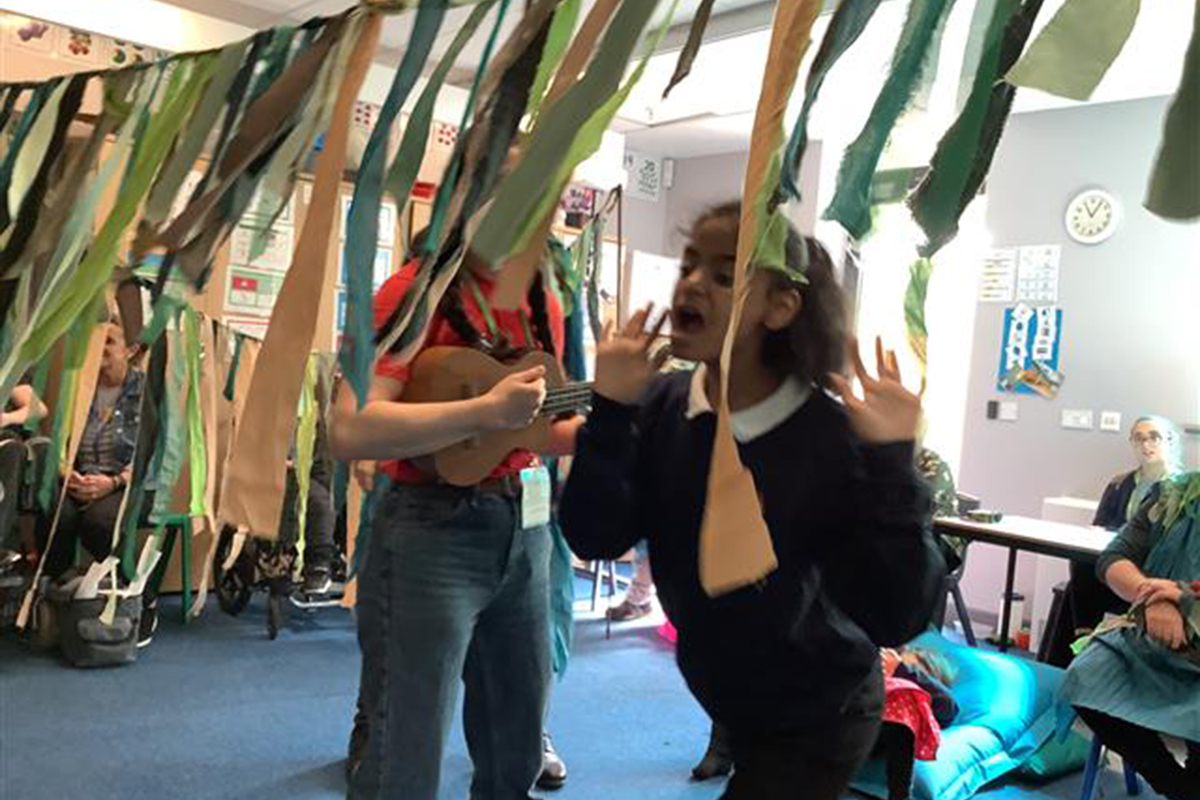Evaluating Nature Connectedness through the senses, emotions, beauty, compassion and meaning

How can people with learning disabilities be supported to engage with the urgent environmental issues of today?
As a Learning Disability Theatre Company we believe we have a distinct part to play in ensuring that everyone is offered opportunities to engage in environmental issues and to move towards environmental activism.
For a while now, DIY has been developing our Environmetal policy and practice. Our Environmental Strategy highlights our commitment to minimising our negative, and increasing our positive, impacts on environmental sustainability. (View an easy read version of our Environmental Sustainability Policy.)
We want to raise environmental awareness and inspire action for positive environmental change through performances, workshops, training and digital resources.”
Our main focus to date has been on developing projects that highlight environmental issues. In 2021 and 22 we developed poems and recordings for the Peel Park Sculpture Trail about the polluted past of our local area and how it impacted the environment.
Looking back
Pollution in the Irwell
Dirty smoky factories
Poison in the water
Choking wildlife
We set our Looking Back: Facing Forward project within the natural environment of Peel Park. Audiences were taken on a journey through time and space to Look Back on Salford’s History and Face Forward to all our Futures. The show demonstrated that people with learning disabilities have a voice and can take action – including action to protect our environment.

Hanging by a Thread is DIY’s new multi-sensory performance. It uses interactive theatre, songs, live music, puppets and sensory props to create a magical experience for each audience member.
During the show actors encourage the audience to connect with the natural world. They journey into a wood, meet a magical tree and brightly coloured magical birds. Pre and post show workshops further explore the themes of nature connectedness and environment with children and young people with learning disabilities.
Evaluating Nature Connectedness through the senses, emotions, beauty, compassion and meaning.
As part of our Hanging by a Thread project we have been exploring how we can evaluate the impacts of our work on nature connectedness.
Nature connectedness captures that relationship between people and the rest of nature. It is a measurable psychological construct that moves beyond contact with nature to an individual’s sense of their relationship with the natural world.”
Derby Nature Connectedness Research Group www.derby.ac.uk/research/centres-group
According to the Derby Research Group, the pathways to nature connectedness are the senses, emotions, beauty, meaning and compassion. These features provide a useful framework that we can adapt to develop inclusive and accessible evaluation approaches to exploring nature-connectedness.
We used a participatory approach to evaluate Hanging by a Thread. Firstly we used a sound and action exercise to introduce each pathway Next we broke into smaller groups to create a frozen image of what actors had observed during sessions. Lastly we came together as a bigger group to discuss what we saw in each image and the ideas that emerged. We documented a series of quotations that emerged from this activity. Some of these are included below:

Nature Connectedness through the Senses
“The children follow the lights – they like the lights on the birds and on the big tree when they go through the forest”
“They like to touch the fabrics – they like touching the silks – it feels nice to touch”
“They like the bells and the sound of the music – all the different instruments – the chimes and the stringed instruments”
“They like moving through the trees, when Woolly invites them into the forest”
Nature Connectedness through the Emotions
“The show makes us happy, angry, upset at different times”
“It makes us feel joyful when we think about the magic bird and the tree and lots of other trees in the woods”
“It makes the children happy to see us all dressed up – they like to feel the costumes – feel the fabric”
“Singing the songs makes us feel happy and it makes them feel happy”
Nature Connectedness through Beauty
“The beauty of the birds makes the children happy”
“The lights on the birds are beautiful – the children track the lights – if they can’t follow the sounds, they follow the lights”
“The colours are beautiful – the orange birds are like the sunset”
Nature Connectedness through Compassion
“ We feel sorry when the tree gets chopped down”
“The children feel sad about the wildlife and the birds in the tree”
“It’s sad because the birds have got no home – that’s why we need the trees – we need to bring the trees back to life again”
DIY are helping ensure that everyone is offered opportunities to engage in environmental issues

The nature connectedness framework has offered us a good starting point to identify the ways in which DIY’s multi-sensory performances and workshops can increase nature connectedness amongst performers and audiences alike. It is just a starting point, and as we develop the show further for touring, we plan to build on and develop this inclusive evaluation methodology, as a way of documenting and improving our work and exploring the ways in which our performances and workshops can impact on environmental awareness and action.
‘Hanging by a Thread’ is created and performed by actors with learning disabilities.
We are very grateful to Arts Council England who are funding this work.
